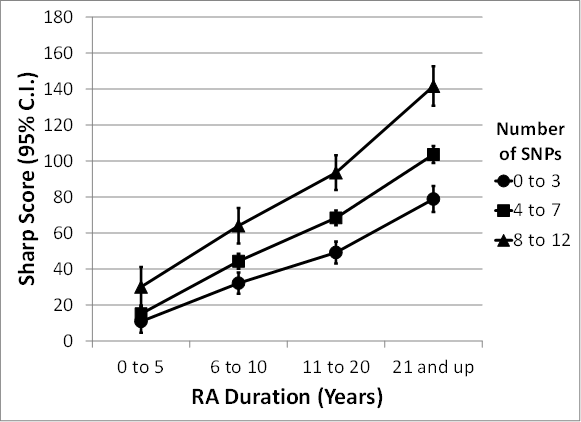Session Information
Session Type: ACR Poster Session A
Session Time: 9:00AM-11:00AM
Background/Purpose:
Genealogical and genetic
association studies have suggested that joint damage in rheumatoid arthritis (RA)
may be heritable. We and others have found a number of specific genetic
variants associated the extent of rheumatoid joint damage. Here, we estimate
the cumulative association of single nucleotide polymorphisms (SNPs) associated
with joint damage in a cohort of Mexican Americans (MA) and European Americans
(EA) with RA.
Methods:
We recruited MA and EA
patients with RA from rheumatology practices, and followed them over time. We used
the Immunochip array to identify single nucleotide polymorphisms associated
with the extent of radiographic joint damage on the latest available
radiograph, quantified by inverse normal Sharp scores. Association analyses
were conducted using PLINK, adjusting for age at RA onset, sex, RA duration and
the first two ethnic principal components to adjust for population
stratification. Association analyses were stratified by ethnic group. We
excluded SNPs with call rates below 95% or minor allele frequencies below 1%, and
patients with admixture or cryptic kinship relationships. We used the six SNPs
with the strongest association with joint damage in each ethnic group as
defined by a P-value ≤ 10-5, to construct a cumulative scale by summing
the number of damage-associated alleles in each patient. We examined the
association of the cumulative SNP scale with joint damage progression over the
duration of the study using scale x RA duration product terms in generalized
estimating equations adjusted for age at RA onset, sex and ethnic group.
Results:
Genotypic and joint
damage data were available for 675 MAs and 410 EAs. These patients had 3,186
Sharp scores available, covering a period of 4,149 patient-years (mean 3.8
years per patient, range 0 to 19). The Sharp score increased by 4.1 per year of
disease (95% C.I. 3.98, 4.35), without difference between ethnic groups. The
mean number of damage-associated SNPs in each patient was 4.4 (range 0 to 12),
each additional SNP associated with an increase Sharp progression rate of 0.2 per
year (95% CI 0.1, 0.3; P ≤ 0.001). Among patients with 3 or less risk
alleles, Sharp increased by 3.6 per year (3.4, 3.9); among patients with 4 to 6
alleles, Sharp increased by 4.1 per year (3.9, 4.3), and among patients with 7
or more alleles, Sharp increased by 4.9 per year (4.5, 5.3). The figure plots
Sharp score over disease duration, according to the number of damage associated
SNPs.
Conclusion:
Genetic variants
associated with joint damage display a cumulative association, patients with a
greater number of SNPs displaying greater joint damage. These findings may
provide insights into the biology of joint damage in RA and if validated in
other populations, could be of use for the early identification of RA patients
at risk for joint damage.
To cite this abstract in AMA style:
Arya R, del Rincon I, Restrepo JF, Farook VS, Jenkinson CP, Duggirala R, Escalante A. Cumulative Association of Genetic Variants with Rheumatoid Joint Damage Progression in Mexican Americans and European Americans [abstract]. Arthritis Rheumatol. 2015; 67 (suppl 10). https://acrabstracts.org/abstract/cumulative-association-of-genetic-variants-with-rheumatoid-joint-damage-progression-in-mexican-americans-and-european-americans/. Accessed .« Back to 2015 ACR/ARHP Annual Meeting
ACR Meeting Abstracts - https://acrabstracts.org/abstract/cumulative-association-of-genetic-variants-with-rheumatoid-joint-damage-progression-in-mexican-americans-and-european-americans/

